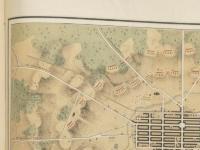Just as strategy, numerical superiority and advanced weaponry are assuredly conducive to military strength and thus victories, so too is the geography of the land on which battles are fought. According to military geologist, Professor Peter Doyle of University College London:
“Geology has controlled the outcome of battle since warfare began. Understanding the nature of ground, the opportunity for active defense and tunneling, the ability to move freely across tracts of terrain and the provision of natural resources are some of the problems that have faced armies for centuries.”
The Battle of Gettysburg proved no exception to this assertion.
Map Making during the Civil War:
Map making constituted an integral part of military operations during the Civil War. For commanders, map making allowed them the opportunity to better understand the land over which their armies marched and fought. Commanders entrusted topographical engineers to undertake the task of mapping the topography of a given battlefield to ensure that they intimately understood the surrounding terrain. Prior to March 31, 1863, United States topographical engineers operated within their own corps or groups within the military and otherwise. Thereafter, however, topographical engineers were integrated into the United States Corp of Engineers and most officers had a topographical engineer on their staff. Throughout the Civil War, the Confederate Army suffered from a lack of topographical engineers, thus putting the north at an advantage.
The first of the two maps used in conjunction with this lesson plan was produced by a topographical engineer during the battle, while the second was produced a few months after the battle, using eyewitness accounts from the townspeople, press correspondents, and extractions from diaries, for accuracy. Though little is written on the maps’ respective backgrounds, they accurately assess the situations during the three days of fighting at Gettysburg. They take into account the topography of Gettysburg, the strategic formations pursued by both the Army of Northern Virginia and the Army of the Potomac throughout the battle, while additionally providing specific dates and locations of certain units and brigades during the battle.
The first map, created by Captain and Aide-de-Camp, William Willcox of General John F. Reynolds’ Staff, who also served as his topographical engineer, shows much of the aforementioned. Willcox’s map provides the viewer with a macro-view of the battle situation at 2pm on July 2nd, just as the Army of Northern Virginia was preparing its assaults against the Union flanks. Furthermore, Willcox’s map provides depictions of railroads, road networks, infantry and artillery positions, the names of Union units as well as Corps and their commanders. Moreover, Willcox depicts Confederate battle formations, Union breastworks, and cavalry positions. Special attention is also given to vegetation, and civilian landmarks such as churches, and cemeteries.
Much like the first map, the second, created by Theodore Ditterline, a northern map maker, provides the viewer with an understanding of troop and artillery locations and movements, drainage ditches, road networks around the town, railroads, and houses with the names of residents, for all three days. In essence, these maps have the ability to tell the story of the Battle of Gettysburg through a different lens and at a macro level, allowing the viewer to see and understand the Gettysburg battlefield in its entirety, rather than in a fragmented micro-level manner. From a macro-level view, the viewer can also better understand the significance of geography during the battle, as it allows one to evaluate the entirety of the military situations throughout the battle, as opposed to isolating them.
Background of the Battle:
Following the Battle of Chancellorsville in May of 1863, a victorious Army of Northern Virginia, commanded by Robert E. Lee, decided to launch an invasion of the North. His rationale proved three fold: take the armies out of the war-ravaged Virginia countryside and into the abundant agricultural bastion of Pennsylvania, disrupt any offensive strategies of the Union army, and prevent the Union army from gaining reinforcements from other theaters. Using the Blue Ridge Mountains to shield his army’s movements, Lee moved north on June 3rd, followed closely by Union General Hooker. Towards the end of June, with the Confederate cavalry missing, and ignorant to the Union army’s movements, Lee learned from a spy that the Union army was actively moving north, forcing him to concentrate his forces in the vicinity of the town of Gettysburg, which sat at the hub of 10 major roads. Gettysburg's location made the likelyhood of an army passing through and a military engagement occurring there as a result, very high. Additionally, Hooker having resigned, the Army of the Potomac now fell under the command of General George Gordon Meade. Though Meade never intended for a battle to ensue at Gettysburg, Union cavalry under the command of John Buford, encountered Confederate infantry outside the town, thus prompting both commanders to rush troops to the small Pennsylvania town. The stage was set for the bloodiest battle in American history.

